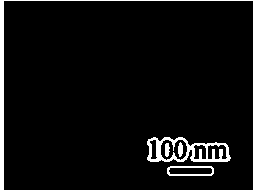Preparation method of halophile photosensitive protein-titanium dioxide nanotube composite
A technology of titanium dioxide and photosensitive protein, applied in biochemical equipment and methods, nanotechnology, nanotechnology, etc., can solve the problem of high probability of photogenerated electron-hole recombination, hindering the industrialization and application of TiO2 photocatalytic materials, and the utilization rate of sunlight low level problem
- Summary
- Abstract
- Description
- Claims
- Application Information
AI Technical Summary
Problems solved by technology
Method used
Image
Examples
Embodiment 1
[0017] Escherichia coli Rossetta strain containing PET28aJ56 plasmid was inoculated in sterilized LB solid medium containing kana antibiotics by streaking method. After 24 hours, a single clone was picked, inoculated in 5 ml of LB liquid culture medium containing kana antibiotics, 200 rpm, and cultured at 37° C. for 24 hours for activation. Transfer 1ml of activated Escherichia coli into 250ml of LB liquid medium for expanded culture. Transfer the expanded and cultivated Escherichia coli to 2L LB liquid medium according to the inoculum amount of 20ml, and cultivate it at 37°C and 200rpm for 2-3 hours. When it reaches 0.6, add IPTG to the final concentration of 1mM in the bacterial solution, add 0.5% retinal, and induce for 4 hours at 37°C. Centrifuge the bacterium solution that has been induced to express the rhodopsin protein at 4000 rpm for 20 minutes, and collect the bacterium. Add 0.01% β-mercaptoethanol and 10% sarkosyl to the pellet, resuspend the bacteria, and ultraso...
Embodiment 2
[0021] Escherichia coli Rossetta strain containing PET28aJ56 plasmid was inoculated in sterilized LB solid medium containing kana antibiotics by streaking method. After 24 hours, a single clone was picked, inoculated in 10 ml of LB liquid culture medium containing kana antibiotics, 200 rpm, and cultured at 37° C. for 24 hours for activation. Transfer 2ml of activated Escherichia coli into 250ml of LB liquid medium for expanded culture. Transfer the expanded and cultivated Escherichia coli to 2L LB liquid medium according to the inoculation amount of 10ml, and cultivate it at 37°C and 200rpm for 2-3 hours, during which the absorbance OD value of the bacteria solution at 600nm is often measured until the OD When it reaches 0.5, add IPTG to the final concentration of 1mM, add 0.5% retinal, and induce for 4 hours at 37°C. Centrifuge the bacterium solution that has been induced to express the rhodopsin protein at 4000 rpm for 20 minutes, and collect the bacterium. Add 0.01% β-mer...
Embodiment 3
[0025] Escherichia coli Rossetta strain containing PET28aJ56 plasmid was inoculated in sterilized LB solid medium containing kana antibiotics by streaking method. After 24 hours, a single clone was picked, inoculated in 5 ml of LB liquid culture medium containing kana antibiotics, 200 rpm, and cultured at 37° C. for 24 hours for activation. Transfer 5ml of activated and cultured Escherichia coli to 2L of LB liquid medium, and cultivate it at 37°C and 200rpm for 6-8 hours. Add IPTG to the bacterial solution to a final concentration of 1 mM, add 0.5% retinal, and induce for 4 hours at 37°C. Centrifuge the bacterium solution that has been induced to express the rhodopsin protein at 4000 rpm for 20 minutes, and collect the bacterium. Add 0.01% β-mercaptoethanol and 10% sarkosyl to the pellet, resuspend the bacteria, and ultrasonically break at 200W for about 30 minutes. Centrifuge at 12000rpm for 20min, and recover the supernatant. Add 0.5% TritonX-100 to the supernatant, mix w...
PUM
| Property | Measurement | Unit |
|---|---|---|
| diameter | aaaaa | aaaaa |
| thickness | aaaaa | aaaaa |
| thickness | aaaaa | aaaaa |
Abstract
Description
Claims
Application Information
 Login to View More
Login to View More - R&D
- Intellectual Property
- Life Sciences
- Materials
- Tech Scout
- Unparalleled Data Quality
- Higher Quality Content
- 60% Fewer Hallucinations
Browse by: Latest US Patents, China's latest patents, Technical Efficacy Thesaurus, Application Domain, Technology Topic, Popular Technical Reports.
© 2025 PatSnap. All rights reserved.Legal|Privacy policy|Modern Slavery Act Transparency Statement|Sitemap|About US| Contact US: help@patsnap.com

